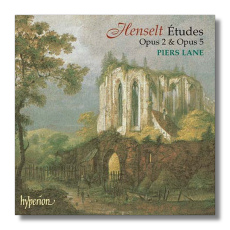
The Internet's Premier Classical Music Source
Related Links
- Latest Reviews
- More Reviews
-
By Composer
-
Collections
DVD & Blu-ray
Books
Concert Reviews
Articles/Interviews
Software
Audio
Search Amazon
Recommended Links
Site News
 CD Review
CD Review
Adolf von Henselt

Works for Solo Piano
- 12 Concert Etudes, Op. 2 (31:07)
- 12 Salon Etudes, Op. 5 (40:05)
- Poeme d'amour - Andante & Etude in B Major, Op. 3 (7:26)
Piers Lane, piano
Recorded Henry Wood Hall, London, May 2004
Released February 2005
Hyperion CDA67495 78:38
Hats off to Hyperion for offering the only disc on the market devoted to the solo piano music of Adolf von Henselt (1814-1889). A virtuoso in his day, Henselt is now relegated to the designation of a minor composer of the same time period as Robert Schumann and Frédéric François Chopin. Henselt, born in Bavaria, received his musical training in Munich, Weimar, and Vienna. He also performed and worked extensively in St. Petersburg under the umbrella of the Tsar's daughter, soaking up and contributing to the emerging Russian style of pianism.
First thing to make clear is that Henselt is not the equal of a Chopin or Schumann. Although his melodies are fetching and sometimes compelling, they certainly do not carry the transcendent qualities of the master composers of the Romantic era. Also, Henselt's emotional and architectural breadth is not in the same league. However, his piano music does compare well with that of Balakirev and other composers of the 2nd tier.
The disc at hand well reveals Henselt's technical skills and fine artistry. Taking the Salon and Concert Etudes as a group, we have 24 studies that cover all the major and minor tones of the chromatic scale with impressive difficulty, although they are not sequenced in any particular tonal order. The element of contrast is admirable, and ample variety rests within each study. I do find the Concert Etudes to present a wider and more incisive emotional stream than the Salon Etudes, but both sets are highly rewarding.
Below are my comments about many of the 24 pieces. I excluded a few to avoid excessive repetition on my part:
Op. 2 Etudes:
No. 1 in D minor/Allegro molto agitato – Turbulent music having rolling/galloping bass arpeggios that remind me instantly of Chopin's D minor Prelude from his famous Op. 28 set. In the middle section, the gallop switches to the right hand over a bed of powerful descending chords.No. 2 in D Flat Major/Allegro moderato – A cascading right hand legato ushers in a sparkling melody that becomes increasingly rapturous. Very attractive with sufficient variety.
No. 3 in B minor/Tempo giusto – Descending broken chords from the lower voice and a dramatic upper melody line make for a bitter/sweet piece that ends aggressively.
No. 4 in B Flat Major/Allegretto sostenuto – A poignant 'song without words', the first section has the melody line in the tenor voice, with the middle section's melody line is owned by the soprano voice. A lovely piece.
No. 5 in C Sharp minor/Tempo giusto – Desperation takes hold in the C Sharp minor which takes shape through inversion; the first section's two beginning bars in the right hand are inverted in the middle section by the left hand.
No. 6 in F Sharp Major/Allegro – Built on a shower of cascading notes from the upper voice, this is one of Henselt's most delightful piano pieces.
No. 7 in D Major/Presto animoso – The first section is highlighted by an ascending and playful figure; the middle section is all drama and motor-like rhythms.
No. 8 in E Flat minor/Allegro agitato ed appasionato – Rapturous music built on ascending and descending triplets.
No. 9 in F Major/Allegro – A chordal study with the primary melody first presented in legato form and then altered to staccato.
No. 11 in E Flat Major/Allegretto sostenuto ed amoroso – Lovely upper melody over flowing arpeggios.
No. 12 in B Flat minor/Moderato ma con moto, con afflizione – Desperate ardor and great tension built on a rocking rhythmic pattern.
Op. 5 Etudes:
No. 1 in C minor "Eroica"/Moderato-Presto agitato ed appassionato - A singing melody from the tenor voice over a constant pair of repeated chords is taken over by a rapid-fire representation in staccato form.No. 2 in G Major/Allegro brillante – A study of right-hand arpeggios over demonstrative left-hand chords.
No. 4 in E Major/Andante – A beautifully flowing four-part chorale. Very serene and gives off a wealth of security.
No. 5 in F Sharp minor/Con moto appassionato e dolorosa – Chordal study with right hand melody mirrored inversely by the left hand.
No. 7 in C Major/Molto vivace – Highly virtuosic and delicate arpeggios from the right hand over a three-note figure from the bass.
That does leave one work, the Poeme d'amour, which is a gorgeous 7 ½ minute tribute to Henselt's bride whom he married in 1837. Although a piece of dignity and ceremony, it also is entirely heart-felt and does not outstay its welcome.
Piers Lane does an excellent job of conveying the virtuosity and serious intent of the composer. Lane's phrasing is supple, and he provides the tension and beauty inherent in the scores. The sonics are splendid, possessing a fine richness and well-projected detail.
Don's Conclusions: Not a must-have recording, but the excellent music and performances mandate a strong recommendation for those who love Romantic era piano works. If further interested, please note that Henselt's Piano Concerto is available through the Hyperion Romantic Piano Concerto series, and there is also an MD&G disc devoted to a combination of his solo piano and chamber music. I doubt that Henselt's discography will ever be extensive, but his music would represent a worthy addition to one's music library.
Copyright © 2005/2006, Don Satz




















